From flooded laundry rooms to soaked floors, I’ve seen it all. “Samsung Washer Leaking From Bottom” – a phrase I’ve heard countless times from distressed clients.
I remember one particularly tricky case:
A persistent leak that took three visits to diagnose. So, believe me when I say, I’ve been in the trenches with this issue.
To give you the best advice, I’ve teamed up with Nicholas Banks, an appliance guru from Boston. Together, we’ll arm you with actionable steps to tackle that pesky leak.
Ready to get your hands a little wet? Let’s get to it.
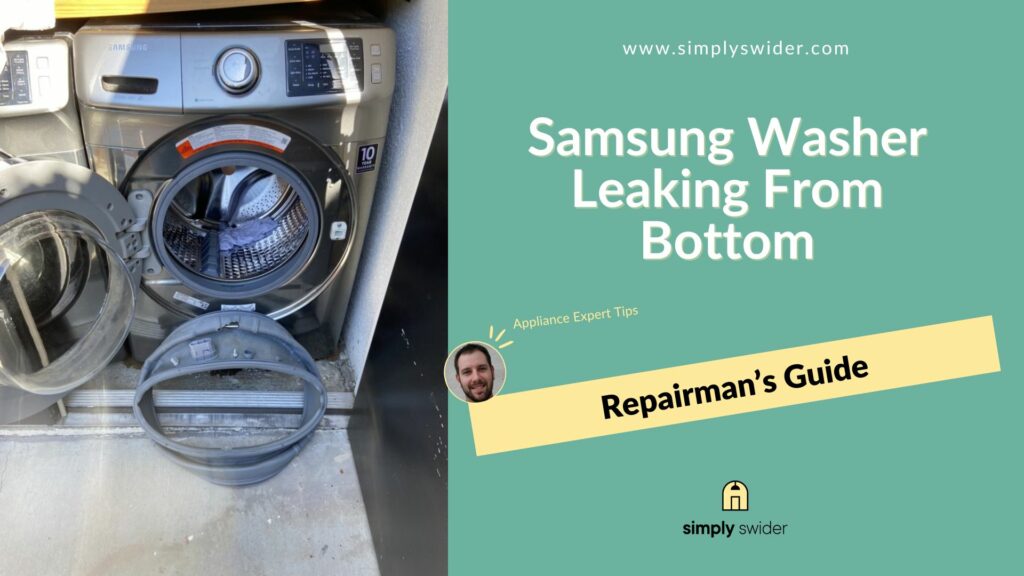
Table of Contents
Why Is Your Samsung Washer Leaking From the Bottom?
Common issues like a clogged drain hose or faulty drain pump often cause Samsung washers to leak from the bottom. But it could also be a worn door boot seal, a malfunctioning bleach dispenser, or even a defective water inlet valve.
I’ve seen all these scenarios in my years fixing appliances, and each has its telltale signs.
Here’s the deal:
Identifying the culprit is half the battle won. Once you know what you’re up against, the fix becomes straightforward.
So, let’s cut to the chase:
I’ve untangled this exact mess more times than I can count. Stick with me, and we’ll get that leak plugged…
Top 5 Reasons Your Samsung Washer Is Leaking From the Bottom & How to Fix Them!
| Commonly Affected Parts | Estimated Cost |
|---|---|
| Drain Hose | $9 – $72 |
| Drain Pump | $12 – $43 |
| Door Boot Seal | $20 – $50 |
| Bleach Dispenser | $24 – $77 |
| Water-Inlet Valve | $6– $42 |
Before we dive in, unplug the washer from the switch and turn off the water supply to avoid any hazards.
Let’s start with the first common issue.
1. Clogged Drain Hose
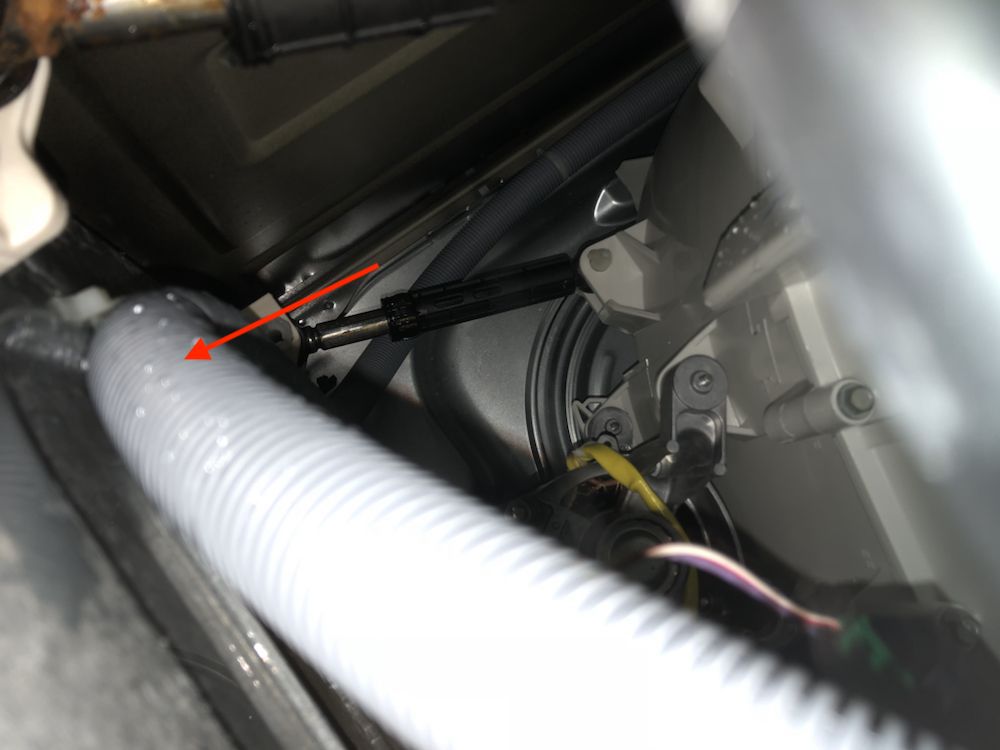
| Part | Drain Hose |
| Location | It is located at the back of the washer next to the drain pump. |
| Ease of troubleshooting | Moderate |
| Cost | $9 – $72 |
| Repairable | Yes – If it is merely clogged with lint or debris No – If it is damaged |
Problem:
The number one reason for a Samsung Washer leaking from the bottom? A clogged or leaky drain hose. I can’t count the number of times I’ve rolled up my sleeves to tackle this issue.
Quick primer:
The drain hose has two ends—one connected to your washer and the other leading to the drainpipe. When that hose gets clogged, you’re asking for trouble. Lint, debris, you name it, they can all mess up the water flow, causing leaks.
Here’s a twist:
This could also be triggering your Samsung washer’s 4C error code.
Identification:
You might wonder, how do you know the hose is clogged?
Nicholas jumps in: “First, you’ve got to open up the machine and inspect that hose for any kinks or blockages.” He’s spot on.
Case in point:
Last month, I got called to fix a leaky Samsung VRT steam washer. I took one look at the pooling water and knew where to head. Lo and behold, the drain hose was jam-packed with lint and grime. The homeowner admitted they’d been slacking on regular cleaning.
Solution:
Time to fix it. Cleaning the drain hose was the game-changer. Want to DIY it?
Follow these steps:
- Step 1: Remove the screws holding the front panel to the frame.
- Step 2: Loosen the clamps securing the drain hose to the pump.
- Step 3: Free the hose by untwisting the twist retainers from the washer tabs.
- Step 4: Unclog that hose. A drain snake or long brush will do the trick.
- Step 5: Check for cracks or leaks in the hose. If you find any, you’ll need to replace the hose.
- Step 6: Reattach the hose and tighten up all the connections.
- Step 7: Test it. Run a cycle to make sure the issue is resolved.
Nicholas chips in: “This isn’t a sprint; it’s a marathon. Follow the steps carefully and take your time to avoid making a mistake.”
2. Damaged Drain Pump
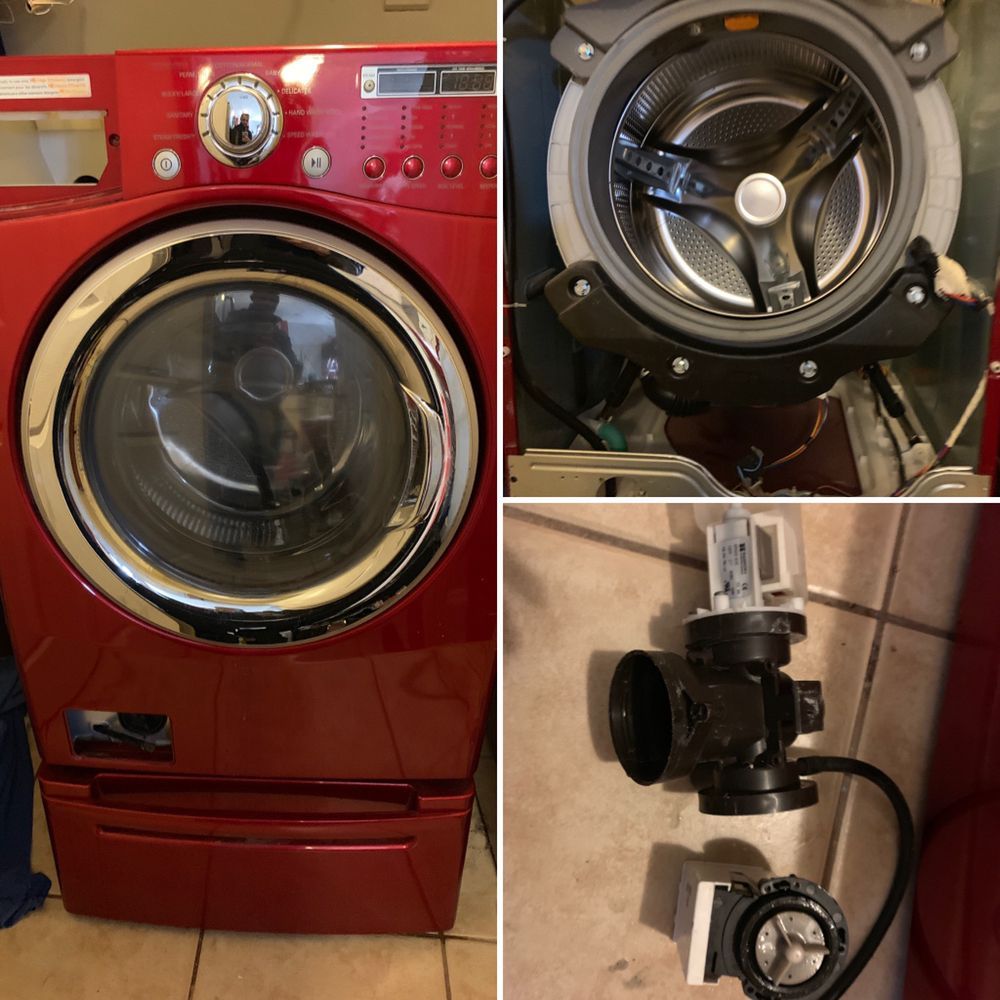
| Part | Drain Pump |
| Location | It is located at the bottom of your washer behind the access panel. |
| Ease of troubleshooting | Easy |
| Cost | $12 – $43 |
| Repairable | No |
Problem:
I can’t tell you how many times I’ve seen a Samsung washer leaking from the bottom due to a damaged drain pump. In this game, experience teaches you a lot, and this is one issue you can’t afford to ignore.
Why?
Because the drain pump is the heart of your washer’s drainage system.
Nicholas chimes in, “The drain pump is your washer’s workhorse for channeling water. When it’s compromised, you’re inevitably looking at a leak.”
Take Harvey, a frequent visitor to our Facebook community. He’d just replaced his drain hose but still had water pooling underneath his Samsung Aquajet Smartcare washer. We urged him to check the drain pump, and voila! That was it.
Identification:
Look, I’ve been down this road enough to know the tricks. First, eyeball your drain pump for cracks or obvious signs of wear. Simple.
Nicholas points out, “Sometimes, it’s not just physical damage. Loose or faulty electrical terminals can also be the culprits.”
Got that? Even if the pump looks pristine, a multimeter can save the day. If you get readings over 50 ohms, it’s replacement time.
Solution:
Ready for some DIY action? Replacing the pump isn’t rocket science if you follow the steps.
- Step 1: Power down your washer and open the rear access panel. That’s where you’ll find the drain pump.
- Step 2: Grab some pliers and loosen the clamps connecting the hoses to the pump. Easy.
- Step 3: Unscrew and unclip the pump from its mounting spot.
- Step 4: Before disconnecting any wires, snap a pic with your phone. Trust me; you’ll thank me later.
- Step 5: Yank the old pump out and remove its bracket.
- Step 6: Slide the new pump into place, secure the bracket, and tighten everything up.
- Step 7: Reconnect those hoses and wires, then run a test wash to make sure you’ve solved the issue.
3. Worn-Out Door Boot Seal
| Part | Door Boot Seal |
| Location | It is located between the outer tub and the front panel of the washer. |
| Ease of troubleshooting | Easy |
| Cost | $20 – $50 |
| Repairable | No |
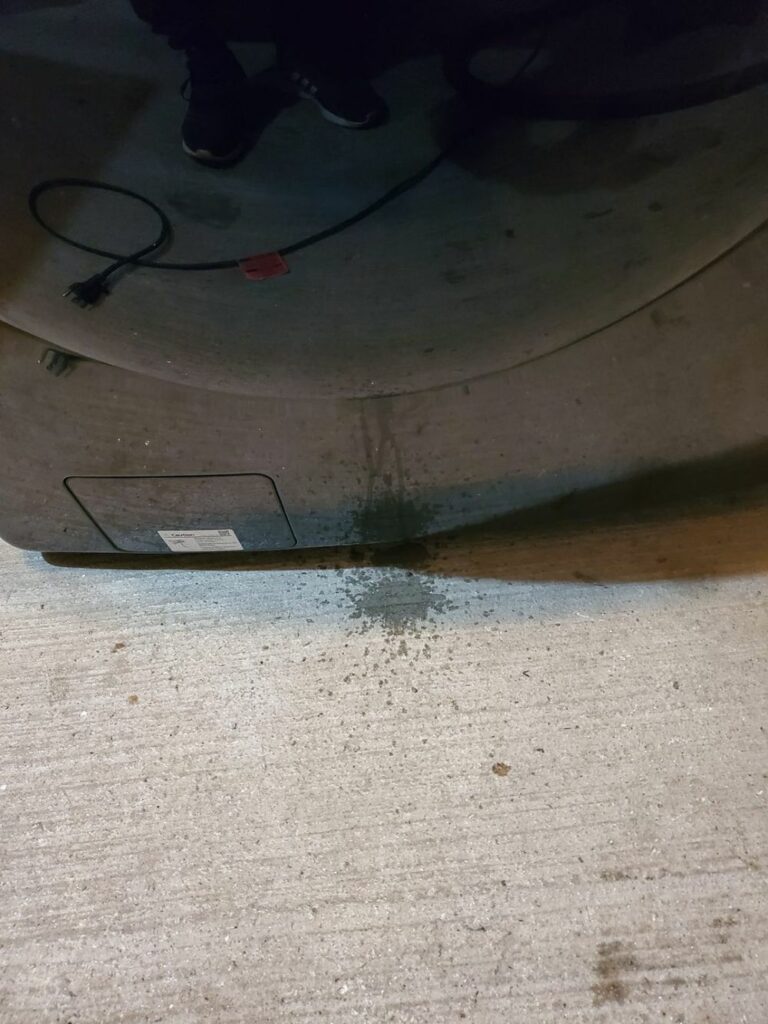
Problem:
So folks, if it’s not the drains, chances are, it’s the door boot seal. The door boot seal is like the unsung hero of your washer, ensuring no water escapes during the spin cycle. But when it wears out or gets loose, that’s when the puddles start.
Identification:
Here’s a tip. Open that washer door and take a good look at the seal. Notice any damages? Misalignments? That’s your culprit.
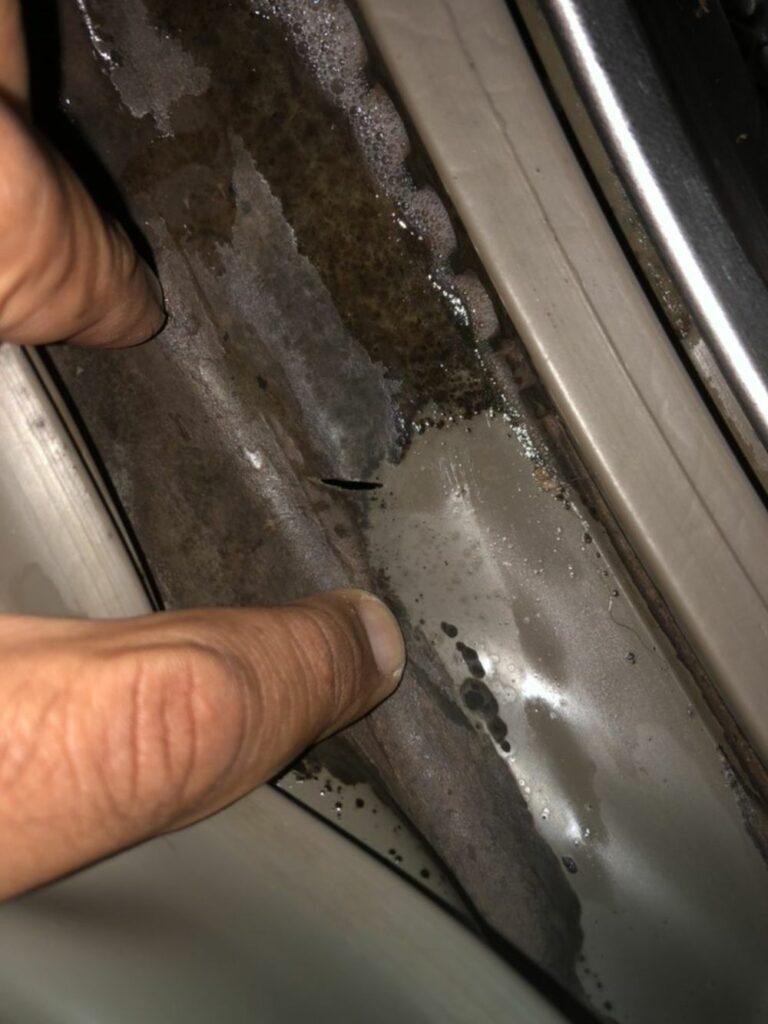
Just last month, a guy reached out to me on our Facebook community page. His laundry room was more like a kiddie pool. Took me five minutes to realize his door boot seal was frayed and worn.
Nicholas chimed in: “This worn-out boot seal prevented the washer door from properly sealing and caused the water to leak out.”
Solution:
So, how to tackle this? Listen up, because I’m about to lay down some trade secrets.
- Step 1: Grab a flat-head screwdriver and unscrew the top panel.
- Step 2: Next, take out the control panel screws and unhook the wire harness.
- Step 3: With the door wide open, locate and detach the door switch and clamp that’s holding the seal tight.
- Step 4: Unthread the front panel entirely. Now, you’ve got access to the door boot seal.
- Step 5: Disconnect the drain hose and loosen the clamp around the seal.
- Step 6: Time to inspect. If that seal is worn, it’s got to go. Replace it.
Nicholas warns: “While replacing, don’t just toss the old seal. There’s a fitting in there you’ll need to transfer to the new seal.”
He adds: “And make sure you align that fitting just right.”
- Step 7: Install the new seal, and make sure everything’s secure.
- Step 8: Put it all back together and give it a test run.
4. Clogged or Cracked Bleach Dispenser
| Part | Bleach Dispenser |
| Location | It is located on the front left side of the washer in the detergent drawer. |
| Ease of troubleshooting | Easy |
| Cost | $24 – $77 |
| Repairable | No |
Problem:
Let’s cut to the chase. You’ve got a leak, and it could be coming from your bleach dispenser. It’s easy to overlook, but vital to address.
Nicholas breaks it down: “When the bleach dispenser gets clogged or cracked, the washer can’t effectively release bleach. The result? A mess at the bottom of your machine”.
Identification:
Do you want proof? Watch your washer closely during the spin cycle. That’s usually when this problem rears its ugly head. If you notice water trickling from the front, you’re onto something.
Nicholas emphasizes: “If the leak is upfront, we can likely rule out drain pumps and hoses, as they’re at the back of your machine”.
Case in point:
A Reddit user with a Samsung washer model WA45HT7200AW had the same issue—leaks during the spin cycle from the front. Guess what solved it? Cleaning a clogged bleach dispenser.
Solution:
Here’s the game plan, plain and simple.
You’ll need some tools: Tape, screwdriver, putty knife, pliers, and a flat-blade screwdriver.
- Step 1: Open the lid. The bleach dispenser is on the side.
- Step 2: Use your fingers to lift and remove the dispenser.
- Step 3: Tape down the lid.
- Step 4: Pop open the top panel using a putty knife.
- Step 5: Off comes the back panel.
- Step 6: Unplug electricals. Turn off the water valve.
- Step 7: Now, unclamp the bleach dispenser hose.
- Step 8: Check for clogs or damage. Clean it if you must or replace it.
- Step 9: Reassemble. Run a test cycle.
Nicholas adds a footnote: “Keep in mind this guide works mainly for Samsung top-loaders. Always consult your model’s specific manual”.
5. Defective Water Inlet Valve
| Part | Water Inlet Valve |
| Location | It is located beneath the access panel at the back of the washer. |
| Ease of troubleshooting | Easy |
| Cost | $6 – $42 |
| Repairable | No |
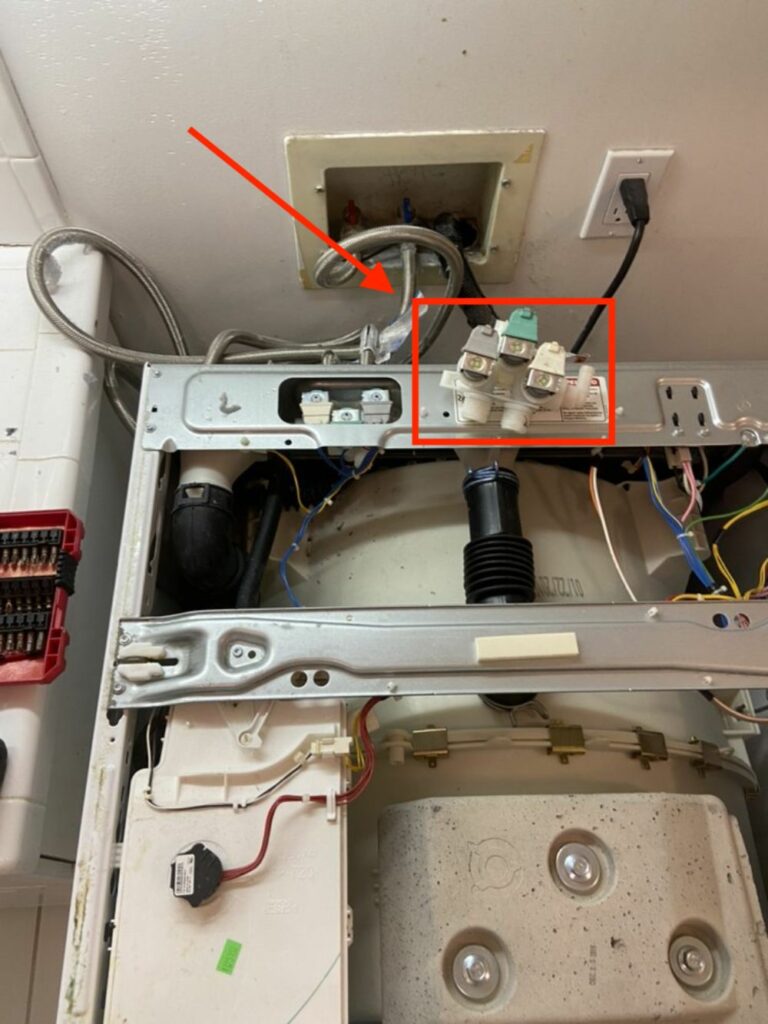
Problem:
Sometimes, the water pooling beneath your washer isn’t from an intricate fault. It might just be a faulty water inlet valve.
You might ask, why does that matter?
Because this valve governs the flow of water into your machine during the wash. When it acts up, there’s trouble.
Nicholas, with his vast knowledge, adds: “When this tiny unit malfunctions, water might take an unintended route—straight to your floor. And that’s a mess nobody wants”.
Identification:
From my on-field encounters, the water inlet valve issue rears its head when you hear the sound of water filling the machine, accompanied by a leak underneath.
Nicholas chips in with a keen observation: “Always listen during the fill cycle. If there’s a leak then, chances are, the inlet valve’s to blame. Inspecting it for any visible wear or cracks is crucial”.
Take this for instance:
I recently came across a Reddit post where a user mentioned their Samsung front-loader, model WF45K6500A, dripping from the bottom, despite having cleaned the drain hose time and again. Their words struck a chord, “I hear the water, but then there’s that drip… only when water is added.”
Piecing this together, Nicholas and I didn’t have to think twice: the culprit was the water inlet valve.
The signs were glaring:
It leaked only when the washer tried to draw water. Plus, their assurance that it wasn’t a drain pump problem made our diagnosis even more concrete.
So, what’s the next logical step?
Inspect that valve.
Solution:
Here’s my tried-and-true approach to fixing this:
- Step 1: Behind the washer, detach the hot and cold-water lines with pliers. (Remember their spots; it’ll save you a headache later.)
- Step 2: Open up the access cover, revealing the water inlet valve.
- Step 3: Carefully disconnect the valve’s electrical connections.
Nicholas interjects, emphasizing: “Four wire connections, each distinct in color. Make a mental note. It’s crucial when you’re reconnecting”.
- Step 4: Unfasten the water inlet valve, inspecting for breaks or damage. Don’t forget to test the solenoid coils with a multimeter. Anything over 50 ohms? You’ll need a replacement.
- Step 5: Out with the old valve, in with the new.
- Step 6: Put everything back, power up, and run a test. No leaks? You’ve nailed it.
Samsung Washer Models Commonly Affected
Let’s get specific:
Some Samsung washer models just seem to love springing leaks more than others. If you own one of these, you’re probably nodding your head right now.
So, to help you get straight to the point, I’ve compiled a list of these ‘leak-prone’ Samsung models and their usual suspects. You might call it my leaky leaderboard.
| Model Name | Model Number | Specific Reason |
|---|---|---|
| Samsung VRT Front-Loader Washer | WF42H5000AW | Clogged drain hose or damaged drain pump. |
| Samsung VRT Steam Washer | WF5000H | Clogged or cracked bleach dispenser unit. |
| Samsung Aquajet Smartcare | WA48H7400AP | This unit often develops faults with the drain pump. It’s also prone to having aclogged drain hose. |
| Samsung Washer Self-Clean WF50K7500AV | WF50K7500AV | Worn-out door boot seal. |
| Samsung Washer model WA40J3000AW | WA40J3000AW | The drain hose gets easily clogged with lint and detergent debris. |
| Samsung front-loading washer model WF45K6500A | WF45K6500A | Defective water inlet valve. |
| Samsung Washer Flexwas | WV60M9900AV | The drain hose gets easily clogged. |
| Samsung Top-Loader WA54R7600AC | WA54R7600AC | Issues with the bleach and detergent dispenser. |
| Samsung washer dc68-02683 | DC68-02683 | Worn-out door boot seal. Also, the drain components are quick to develop faults. |
Conclusion
Fixing a leaky Samsung washer isn’t rocket science, but it can feel like it. Trust me, I’ve seen my fair share of water disasters. The key is zeroing in on the right component.
Quick recap:
- Check the drain hose.
- Examine the drain pump.
- Inspect the door boot seal.
- Look at the bleach dispenser.
- Don’t ignore the water inlet valve.
If you’ve followed our guide and still hit a roadblock, our “Ask the Expert” Facebook repair group is ready and waiting.
Nicholas likes to say, “Prevention beats repair.” So make routine checks a habit.
Tell us your success story. Which tip worked for you? Drop a comment. We’re all ears!

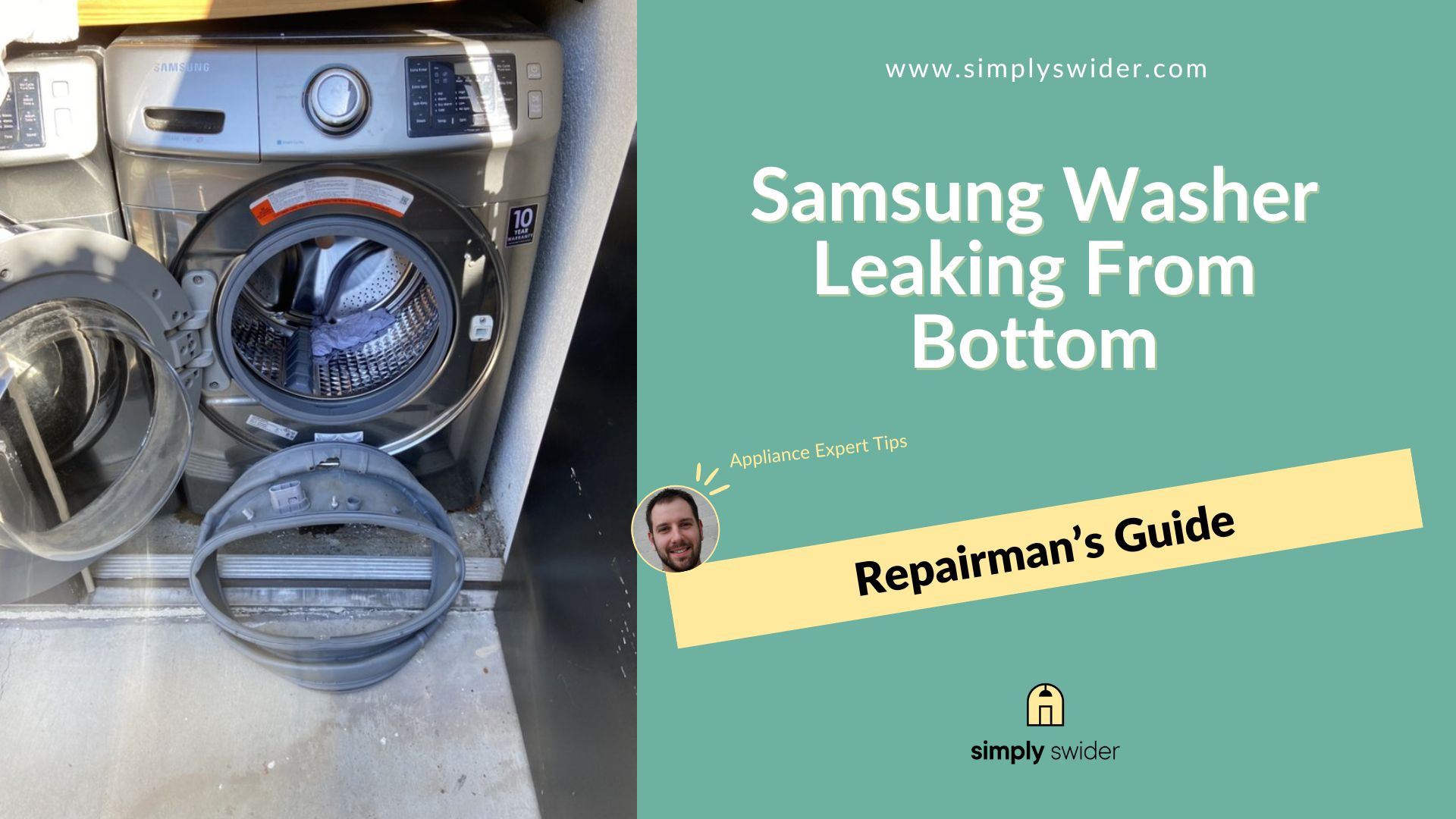
We have had three maintenance people out here to figure out why the water is leaking only occasionally. Not one of them could find a leak. When it leaks you can hear the water pouring out of it. It just doesn’t leak all the time. Samsung top loader , super speed,smart care VRT. It is sure a mystery. Thanks for the info.
Hi Carolyn,
My first thought was the basket is occasionally stuck forward and when it calls for water it hits the rim and some runs out. Upon first look it might not even be noticeable.
Unfortunately water leaks can come from anything water flows through, with it being intermittent is a real tough one. Someone is gonna need to watch that washer do cycles until it’s found.
It makes a technicians job harder when they don’t have much information. Whoever is using the equipment needs to pay attention to details and give them information like what part of the cycle its leaking, does it sound like its pouring, dripping or spraying. He needs to know if it leaks more with a certain type of load.
Thanks. Jason.